
Aloe rupestris Photo by: Valentino Vallicelli
It is a rare and unusual aloe in cultivation. The plant is reportedly one of the fastest tree aloes, so if you want a spectacular flowering tree aloe this is the one you want they say.
Origin and Habitat: It has a wide distribution from Natal, S. Africa, north to Swaziland and southern Mozambique
Habitat: Grows in the summer rainfall area in hot valleys among coastal forest and bushland on sandy soils or over the sun-burned hills on rocky slopes and ridges and cling along low broken sandstone ledges.
Synonyms:
See all synonyms of Aloe rupestris
back
Accepted name in llifle Database:Aloe rupestris BakerFl. Cap. (Harvey) vi. 327.Synonymy: 3
back
Description: Aloe rupestris is a robust fast growing mostly single stemmed tree aloe with very showy flowers. It can grow usually up to 3 m tall (max. 8 m tall) Offsetting forms have been favoured in cultivation.
Stem: Thick, shaggy below, with withered and blackened remains of leaves clothing the upper part, naked on the lower part. The stem often needs support. In habitat it grows in bushes or next to a tree which gives support. The pith is soft, light and spongy.
Roots: It has a spread-root-system the roots are somewhat fleshy.
Leaves: In a compact spiralled rosette at the stem apex in old plants, but in juvenile plants they are ranked in vertical rows. They are strap-like, spreading and recurved, lamina up to about 70 cm long, 7–10 cm wide at the base, lanceolate-attenuate, deeply channelled, dull dark green, smooth, without spots; margin reddish, with pungent deltoid reddish-brown teeth 3–5 mm long and 10–15 mm apart.
Flowers: What is remarkable about this species are its 1 or 2 candelabra-form inflorescences up to 1.25 m tall above the leaf rosette that bear 6-15 or more erect, cylindrical racemes. These are densely packed with very showy yellowish tubular buds that open to become completely overshadowed by the brilliant orange-red, 15 mm exserted stamens. Peduncle stout. The stamens give a very attractive effect. The orange-yellow opening to lemon-yellow perianth has an cylindrical-ellipsoid tube 18–20 mm long, approx 4 mm in diameter across the ovary, widening to 7 mm at the middle and narrowing slightly toward the mouth, with overlapping segments spreading only at the tips Three outer lobes swollen at the base. Ovary somewhat 3-angled. Anthers orange, stigma orange.
Blooming season: Blooms later than most aloes.
Fruits: Capsules.
More...Notes: This species resembles the related A. thraskii and A. excelsa, which also produce rather top-heavy rosettes atop stems clothed in their upper part with a skirt of persistent dried leaves. The racemes of A. excelsa are sloping and the plant is more common. A. thraskii has leaves that are more strongly recurved.
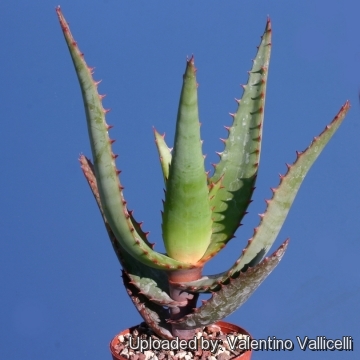 Aloe rupestris Photo by: Valentino Vallicelli
Aloe rupestris Photo by: Valentino Vallicelli Aloe rupestris Photo by: Valentino Vallicelli
Aloe rupestris Photo by: Valentino Vallicelli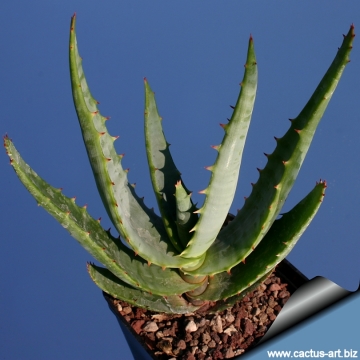 Aloe rupestris Photo by: Cactus Art
Aloe rupestris Photo by: Cactus Art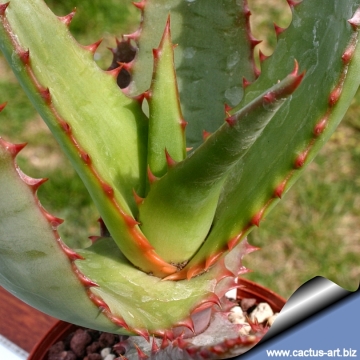 Aloe rupestris Photo by: Cactus Art
Aloe rupestris Photo by: Cactus Art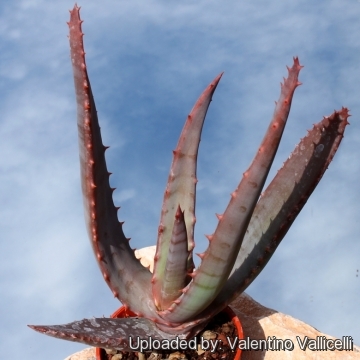 Aloe rupestris Photo by: Valentino Vallicelli
Aloe rupestris Photo by: Valentino Vallicelli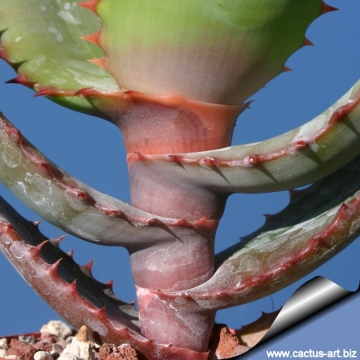 Aloe rupestris Photo by: Cactus Art
Aloe rupestris Photo by: Cactus ArtCultivation and Propagation: Easy to grow, requiring very little care. It can be grown in large containers. Always use a good quality, loamy sandy soil with plenty of drainage chips at the bottom of containers. It tolerates weekly watering in the summer; once a month, or not at all in the colder months of December and January. Can withstand long periods of drought, but they will thrive and flower more profusely if watered in the correct season. Incorrect watering, poor drainage or too much shade can lead to attack by pests and diseases. They can take a few degrees of frost in winter as well, but prefer hot summers. It grows much better outdoors in spring and summer.
In mild climates it can be cultivated outdoors for use in landscaping, preferably planting it in hot and dry rock gardens. They will grow best in regions with a climate close to that of their native deserts not too cold, and not too wet.
They grow slowly, but not agonisingly so being able to increase their height by 10- 30 (or more) cm per year under favourable conditions.
Propagation: Almost exclusively by seeds planted in autumn, in trays of coarse river sand.
Truncheons (if available) can also be used for propagation. Truncheons must be dried out for at least 3 weeks before planting in river sand. This is quite a difficult alternative and success is not always guaranteed.
Uses: Gardening: This tree can be grown in large, rocky, well-drained soil in gardens in drier areas. It is very drought resistant but susceptible to frost.
More...

















